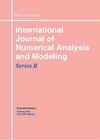边界上任意形状元素的 $hp$ 版本分析 斯托克斯系统的连续伽勒金方法
IF 0.7
4区 数学
Q1 MATHEMATICS
International Journal of Numerical Analysis and Modeling
Pub Date : 2024-06-01
DOI:10.4208/ijnam2024-1021
引用次数: 0
摘要
在本研究中,我们研究并分析了一种 $hp$ 版本的内部惩罚非连续 Galerkin 有限元方法,该方法用于在由边界上多点元素组成的计算网格上对稳定流体系统进行数值逼近。这种方法以非连续 Galerkin 方法为基础,并通过任意形状元素技术加以丰富,如文献 [13] 所介绍的那样。在此框架下,我们利用痕量、马尔可夫型和 $H^1/L^2$ 型逆估计的扩展,对任意形状的元素进行了研究,并考察了静止斯托克斯流体系统,从而证明了 inf/sup 条件和 $hp$- 先验误差估计,同时对最佳收敛速率进行了数值研究。这种方法恢复并整合了流体非连续 Galerkin 方法的灵活性和优越性,在发生几何变形时,只需在边界上退化多面体元素的边缘、面,同时结合基于任意形状元素的 $hp$ 版本技术的效率,而无需从给定参考框架进行任何映射。本文章由计算机程序翻译,如有差异,请以英文原文为准。
$hp$-Version Analysis for Arbitrarily Shaped Elements on the Boundary Discontinuous Galerkin Method for Stokes Systems
In the present work, we examine and analyze an $hp$-version interior penalty discontinuous Galerkin finite element method for the numerical approximation of a steady fluid system on
computational meshes consisting of polytopic elements on the boundary. This approach is based
on the discontinuous Galerkin method, enriched by arbitrarily shaped elements techniques as has
been introduced in [13]. In this framework, and employing extensions of trace, Markov-type, and $H^1/L^2$-type inverse estimates to arbitrary element shapes, we examine a stationary Stokes fluid
system enabling the proof of the inf/sup condition and the $hp$- a priori error estimates, while we
investigate the optimal convergence rates numerically. This approach recovers and integrates the
flexibility and superiority of the discontinuous Galerkin methods for fluids whenever geometrical
deformations are taking place by degenerating the edges, facets, of the polytopic elements only
on the boundary, combined with the efficiency of the $hp$-version techniques based on arbitrarily
shaped elements without requiring any mapping from a given reference frame.
求助全文
通过发布文献求助,成功后即可免费获取论文全文。
去求助
来源期刊
CiteScore
2.10
自引率
9.10%
发文量
1
审稿时长
6-12 weeks
期刊介绍:
The journal is directed to the broad spectrum of researchers in numerical methods throughout science and engineering, and publishes high quality original papers in all fields of numerical analysis and mathematical modeling including: numerical differential equations, scientific computing, linear algebra, control, optimization, and related areas of engineering and scientific applications. The journal welcomes the contribution of original developments of numerical methods, mathematical analysis leading to better understanding of the existing algorithms, and applications of numerical techniques to real engineering and scientific problems. Rigorous studies of the convergence of algorithms, their accuracy and stability, and their computational complexity are appropriate for this journal. Papers addressing new numerical algorithms and techniques, demonstrating the potential of some novel ideas, describing experiments involving new models and simulations for practical problems are also suitable topics for the journal. The journal welcomes survey articles which summarize state of art knowledge and present open problems of particular numerical techniques and mathematical models.

 求助内容:
求助内容: 应助结果提醒方式:
应助结果提醒方式:


